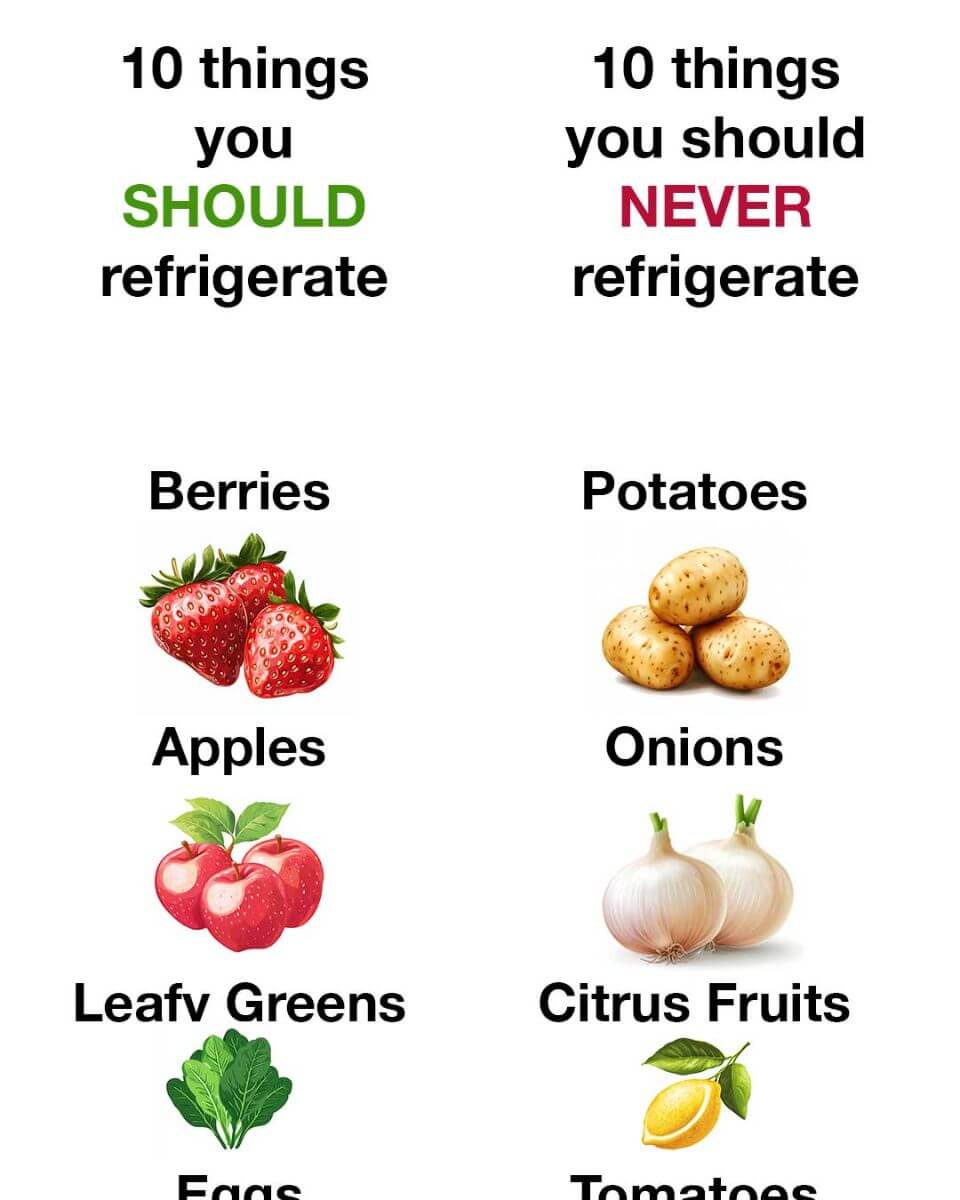Proper food storage plays a crucial role in maintaining freshness, preserving nutrients, and ensuring food safety. Some foods thrive in the refrigerator, while others can suffer in quality when exposed to cold temperatures. Understanding the best storage methods can help prevent spoilage and reduce waste. Below is a guide to which foods belong in the fridge and which are better left out.
Why Refrigeration Matters
Refrigeration helps slow the growth of bacteria and mold, which can otherwise cause food to spoil quickly. By storing certain foods at a lower temperature, you can prolong their shelf life and retain their flavor. However, not every food benefits from being refrigerated—some actually deteriorate faster when exposed to cold temperatures.
10 Foods That Should Always Be Refrigerated
Certain foods require refrigeration to maintain their quality and prevent spoilage. Here are ten items that should always be kept in the fridge:
-
Berries: Preventing Mold and Prolonging Freshness
Berries, such as strawberries, blueberries, and raspberries, are delicate and prone to mold growth. Storing them in the refrigerator slows down spoilage and keeps them fresh for longer. A breathable container helps prevent excess moisture buildup. -
Apples: Maintaining Crispness and Extending Shelf Life
While apples can sit at room temperature for a short period, refrigeration significantly extends their lifespan and keeps them crisp. Storing them in the crisper drawer works best. -
Leafy Greens: Retaining Nutrients and Freshness
Spinach, kale, and lettuce wilt quickly if not kept in a cool environment. Storing them in the fridge with a paper towel to absorb moisture helps maintain their texture and nutrients. -
Dairy Products: Preventing Spoilage
Milk, cheese, and yogurt must be refrigerated to prevent bacterial growth and keep them fresh. Always seal them properly to maintain quality. -
Eggs: Enhancing Safety and Longevity
Storing eggs in the refrigerator reduces the risk of Salmonella contamination and prolongs their usability. -
Cooked Meats: Preserving Flavor and Preventing Bacteria Growth
Leftover meats like chicken, beef, and pork should be stored in airtight containers in the fridge to maintain their moisture and prevent contamination. -
Leftovers: Reducing Waste and Ensuring Safety
Any cooked food should be refrigerated within two hours to prevent bacteria from multiplying. Using airtight containers helps preserve their taste and texture. -
Fresh Herbs: Maintaining Flavor and Longevity
Herbs like parsley, cilantro, and basil tend to wilt quickly. Keeping them in a glass of water covered with a plastic bag extends their freshness. -
Opened Condiments: Keeping Them Fresh and Safe
Once opened, condiments like ketchup, mayonnaise, and salad dressings should be refrigerated to prevent spoilage and bacterial growth. -
Fresh Juices: Preserving Nutrients and Preventing Fermentation
Freshly squeezed juices are best stored in the refrigerator to retain their vitamins and prevent fermentation.
10 Foods That Should Never Be Refrigerated
While refrigeration helps many foods, some items lose their quality when exposed to cold temperatures. Here are ten foods that should not be stored in the fridge:
-
Potatoes: Maintaining Texture and Flavor
Cold temperatures cause the starch in potatoes to turn into sugar, leading to an unpleasant taste and texture. Store them in a cool, dark place instead. -
Onions: Preventing Mold and Softening
Onions absorb moisture in the fridge, leading to mold and mushiness. A well-ventilated area at room temperature is the best storage option. -
Citrus Fruits: Retaining Flavor and Juiciness
Refrigeration can cause citrus fruits to lose their natural sweetness. Keep them at room temperature for the best taste. -
Tomatoes: Preserving Their Natural Texture
Cold temperatures make tomatoes mealy and diminish their flavor. Store them at room temperature and allow them to ripen naturally. -
Bread: Preventing Dryness and Staleness
Refrigerating bread speeds up the staling process, making it dry and unappetizing. Keep it in a bread box or pantry for freshness. -
Honey: Avoiding Crystallization and Hardening
Cold temperatures cause honey to crystallize and harden. Store it in a sealed container in a cool, dry place instead. -
Coffee: Maintaining Aroma and Freshness
Coffee beans and grounds absorb moisture and odors when refrigerated, which affects their taste. An airtight container in a dark, dry area is ideal. -
Garlic: Preventing Sprouting and Moisture Buildup
Refrigerating garlic leads to premature sprouting and a rubbery texture. Store it in a dry, well-ventilated area. -
Bananas: Allowing Proper Ripening
Cold temperatures slow the ripening process of bananas and cause their skin to brown. Keep them at room temperature until they are ripe. -
Avocados: Controlling Ripening
If avocados are not yet ripe, refrigeration slows the process down too much. Keep them at room temperature until they are ready to eat.
Final Thoughts on Food Storage
Knowing which foods to refrigerate and which to store at room temperature is essential for maintaining their freshness and preventing waste. By following these storage guidelines, you can enhance food quality, extend shelf life, and enjoy meals at their best. Always consider the unique storage needs of each food item to ensure optimal taste and safety.
